
Alisa Strauss, Ph.D., has an eye for harmoniously blending the unrelated – so much so that you might wonder how they ever existed separately. The University of Cincinnati anthropology professor has developed a novel technique to apply the concepts of human culture and behavior to her newest venture into graphic design, after earning a master’s degree in the subject. Some of her obscure research topics led her to OhioLINK’s resources which in turn led her to a design stint – creating the graphics for OhioLINK’s Pelotonia jerseys. Pelotonia is a bike tour with one goal – end cancer – involving riders and volunteers from throughout the state of Ohio and beyond.
“I looked at (the OhioLINK) logo and I looked at the Pelotonia stuff, and I thought about ways to blend those together,” Strauss said. “And trying to make it look fast.”
By understanding the audiences of OhioLINK and Pelotonia, Strauss created a design that won OhioLINK’s jersey design contest. The strategy of investigating her audiences also influenced her graphic design master’s thesis.
 Strauss always had a passing interest in print art and particularly enjoyed art that was created for a purpose, such as symbols and signs. The process for designing icons and symbols usually involves the artist creating a design and then asking groups of people if they know what it means. The artist then edits the design based on the feedback he or she receives. As Strauss was researching her master’s thesis, her background in anthropology came into play. She decided to let the culture of the intended audience for the icon inform the design stage. She then created an image based on what the intended audience knows and understands.
Strauss always had a passing interest in print art and particularly enjoyed art that was created for a purpose, such as symbols and signs. The process for designing icons and symbols usually involves the artist creating a design and then asking groups of people if they know what it means. The artist then edits the design based on the feedback he or she receives. As Strauss was researching her master’s thesis, her background in anthropology came into play. She decided to let the culture of the intended audience for the icon inform the design stage. She then created an image based on what the intended audience knows and understands.
“Understanding a bit more about people and the way people act and think and interact I think would really help not just me, but all designers in their quest to have better designs because designs are no good if people don’t understand them or don’t use them,” Strauss said.
For her thesis, Strauss found medical symbols that another artist designed with the traditional guess-and-check method that garnered close to zero audience comprehension in a previous study. She then gathered background research on cultures and ideas through OhioLINK’s extensive literature and journal archives to inform new designs to replace the ones from the previous study. Her designs resulted in better audience comprehension, a promising result that helped affirm her thesis.
“You think that you’ve got a great new idea, but you don’t know until you’ve done a full lit review and really investigated what other people in the world have done,” Strauss said. “That’s where you need a resource like OhioLINK. I don’t know how people do anything without it.”
After finishing her master’s degree, Strauss plans to co-author articles for design journals later this year. For references, she said, she will be sure to turn to OhioLINK. When she’s not teaching anthropology courses or breaking ground in graphic design research, Strauss said she will continue to take on graphic design projects – if only for her own enjoyment.
“I was just happy to design the jerseys because, quite frankly, it was really fun,” Strauss said.
#
Written by Audrey Carson

